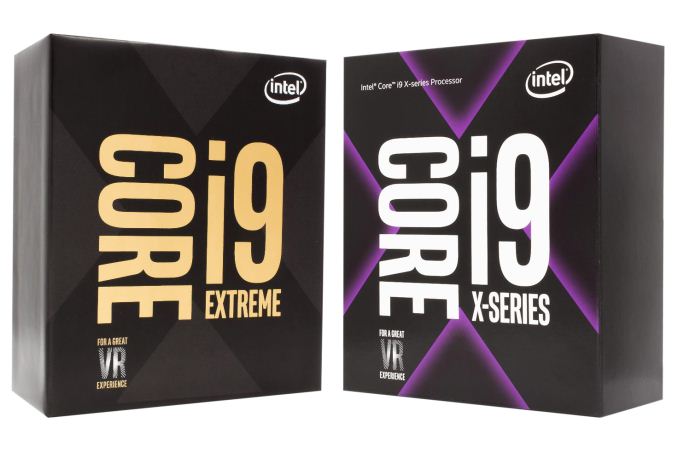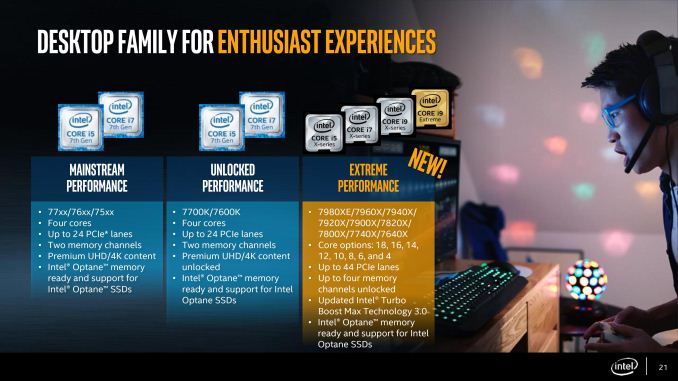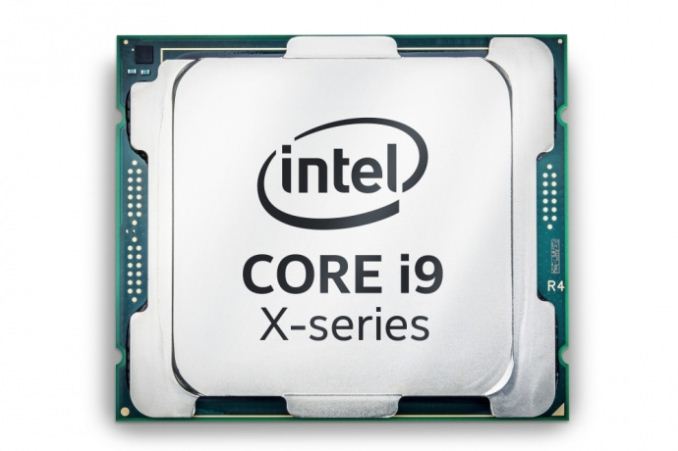Intel Announces Skylake-X: Bringing 18-Core HCC Silicon to Consumers for $1999
by Ian Cutress on May 30, 2017 3:03 AM EST
There are days in this profession in which I am surprised. The longer I stay in the technology industry, they become further and further apart. There are several reasons to be surprised: someone comes out of the blue with a revolutionary product and the ecosystem/infrastructure to back it up, or a company goes above and beyond a recent mediocre pace to take on the incumbents (with or without significant financial backing). One reason is confusion, as to why such a product would ever be thought of, and another is seeing how one company reacts to another.
We’ve been expecting the next high-end desktop version of Skylake for almost 18 months now, and fully expected it to be an iterative update over Broadwell-E: a couple more cores, a few more dollars, a new socket, and done. Intel has surprised us with at least two of the reasons above: Skylake-X will increase the core count of Intel’s HEDT platform from 10 to 18.
The Skylake-X announcement is a lot to unpack, and there are several elements to the equation. Let’s start with familiar territory: the first half of the processor launch.
Announcement One: Low Core Count Skylake-X Processors
The last generation, Broadwell-E, offered four processors: two six-core parts, an eight-core part, and a top-tier 10-core processor. The main difference between the two six-core parts was the PCIe lane count, and aside from the hike in pricing for the top-end SKU, these were iterative updates over Haswell-E: two more cores for the top processor.
This strategy from Intel is derived from what they call internally as their ‘LCC’ core, standing for ‘low core count’. The enterprise line from Intel has three designs for their silicon – a low core count, a high core count, and an extreme core count: LCC, HCC, and XCC respectively. All the processors in the enterprise line are typically made from these three silicon maps: a 10-core LCC silicon die, for example, can have two cores disabled to be an 8-core. Or a 22-core XCC die can have all but four cores disabled, but still retain access to all the L3 cache, to have an XCC processor that has a massive cache structure. For the consumer HEDT platform, such as Haswell-E and Broadwell-E, the processors made public were all derived from the LCC silicon.
The first half of the Skylake-X processor llineup follows this trend. Intel will launch four Skylake-X processors based on the LCC die, which for this platform will have a maximum of 12 cores. All processors will have hyperthreading.
| Skylake-X Processors (Low Core Count Chips) | ||||
| Core i7-7800X | Core i7-7820X | Core i9-7900X | Core i9-7920X | |
| Cores/ Threads |
6/12 | 8/16 | 10/20 | 12/24 |
| Base Clock | 3.5 GHz | 3.6 GHz | 3.3 GHz | TBD |
| Turbo Clock | 4.0 GHz | 4.3 GHz | 4.3 GHz | TBD |
| TurboMax Clock | N/A | 4.5 GHz | 4.5 GHz | TBD |
| L3 | 8.25 MB | 11 MB | 13.75 MB | TBD (Likely 13.75 MB) |
| PCIe Lanes | 28 | 44 | TBD (Likely 44) |
|
| Memory Channels | 4 | |||
| Memory Freq | DDR4-2400 | DDR4-2666 | TBD | |
| TDP | 140W | TBD | ||
| Price | $389 | $599 | $999 | $1199 |
The bottom processor is the Core i7-7800X, running at 3.5 GHz with a 4.0 GHz turbo. This design will not feature Intel’s new ‘favored core’ Turbo 3.0 technology (more on that below), but will have six cores, support quad-channel memory at DDR4-2400, come in at a TDP of 140W, have 28 PCIe lanes, and retail for around $400. This processor will be the entry level model, for any user who needs the benefit of quad-channel memory but perhaps doesn’t need a two-digit number of cores or has a more limited budget.
Next up is the Core i7-7820X, which hits a potential sweet spot in the LCC design. This is an eight-core processor, with the highest LCC base clock of 3.6 GHz and the joint-highest turbo settings: 4.3 GHz for regular turbo and 4.5 GHz for favored core. Unlike the previous processor, this CPU gets support for DDR4-2666 memory.
However in another break from Intel’s regular strategy, this CPU will only support 28 PCIe lanes. Normally only the lowest CPU of the HEDT stack would be adjusted in this way, but Intel is using the PCIe lane allocation as another differentiator as a user considers which processor in the stack to go for. This CPU also runs in at 140W, and comes in at $600. At this price, we would expect it to be competing directly against AMD’s Ryzen 7 1800X, which will be the equivalent of a generation behind in IPC but $100 cheaper.
| Comparison: Core i7-7820X vs. Ryzen 7 1800X | ||
| Intel Core i7-7820X |
Features | AMD Ryzen 7 1800X |
| 8 / 16 | Cores/Threads | 8 / 16 |
| 3.6 / 4.3GHz (4.5 GHz TMax) |
Base/Turbo | 3.6 / 4.0 GHz |
| 28 | PCIe 3.0 Lanes | 16 |
| 11 MB | L3 Cache | 16 MB |
| 140 W | TDP | 95 W |
| $599 | Price (MSRP) | $499 |
The third processor is also a change for Intel. Here is the first processor bearing the new Core i9 family. Previously we had Core i3, i5 and i7 for several generations. This time out, Intel deems it necessary to add another layer of differentiation in the naming, so the Core i9 naming scheme was the obvious choice. If we look at what the Core i9 name brings to the table, the obvious improvement is PCIe lanes: Core i7 processors will have 28 PCIe lanes, while Core i9 processors will have 44 PCIe lanes. This makes configuring an X299 motherboard a little difficult: see our piece on X299 to read up on why.
Right now the Core i9-7900X is the only Core i9 with any details: this is a ten core processor, running with a 3.3 GHz base, a 4.3 GHz turbo and a 4.5 GHz favored core. Like the last processor, it will support DDR4-2666 and has a TDP of 140W. At this level, Intel is now going to charge $100/core, so this 10-core part runs in at a $999 tray price ($1049 retail likely).
One brain cell to twitch when reading this specification is the price. For Ivy Bridge-E, the top SKU was $999 for six-cores. For Haswell-E, the top SKU was $999 for eight-cores. For Broadwell-E, we expected the top SKU for 10-cores to be $999, but Intel pushed the price up to $1721, due to the way the enterprise processors were priced. For Skylake-X, the new pricing scheme is somewhat scrapped again. This 10-core part is now $999, which is what we expected the Broadwell-E based Core i7-6950X to be. This isn’t the top SKU, but the pricing comes back down to reasonable levels.
Meanwhile for the initial launch of Skylake-X, it is worth noting that this 10-core CPU, the Core i9-7900X, will be the first one available to purch. More on that later.
Still covering the LCC core designs, the final processor in this stack is the Core i9-7920X. This processor will be coming out later in the year, likely during the summer, but it will be a 12-core processor on the same LGA2066 socket for $1199 (retail ~$1279), being part of the $100/core mantra. We are told that Intel is still validating the frequencies of this CPU to find a good balance of performance and power, although we understand that it might be 165W rather than 140W, as Intel’s pre-briefing explained that the whole X299 motherboard set should be ready to support 165W processors.
In the enterprise space, or at least in previous generations, Intel has always had that processor that consumed more power than the rest. This was usually called the ‘workstation’ processor, designed to be in a single or dual socket design but with a pumped up frequency and price to match. In order for Intel to provide this 12-core processor to customers, as the top end of the LCC silicon, it has to be performant, power efficient, and come in at reasonable yields. There’s a chance that not all the factors are in place yet, especially if they come out with a 12-core part that is clocked high and could potentially absorb some of their enterprise sales.
Given the expected timing and launch for this processor, as mentioned we were expecting mid-summer, that would have normally put the crosshairs into Intel’s annual IDF conference in mid-August, although that conference has now been canned. There are a few gaming events around that time to which Intel may decide to align the launch to.












203 Comments
View All Comments
shady28 - Tuesday, May 30, 2017 - link
Looks like a marketing stunt to me. I welcome the 6c/12t part, but most applications can't even effectively use 4c/8t processors. It is a complete waste for 99% of buyers and even the remaining 1% are likely to rarely see a benefit.Maleorderbride - Tuesday, May 30, 2017 - link
Your statement just betrays your ignorance and your lack of imagination. Computers are tools for quite a few people, so they will pay considerable sums for better tools which in turn earn them more money.Video editing and 3D work can and will use all cores. While I am not going to claim they are a large percentage of the market, they routinely purchase 8/10 core options. I have quite a few customers running X99 boards with a single E5-2696 V4 dropped in ($1400 on ebay) and it excels in some workflows.
They are not "rarely" use these extra cores--they are using them every single day and it is the primary reason for purchase.
shady28 - Tuesday, May 30, 2017 - link
Lol! The childish insults aside, you think those thoughts you regurgitated are new? Professional video editors make a tiny fraction of a tiny fraction of the market, and if they are smart they aren't using CPUs for much. Most people who profess this 'need' to do 3D video editing are playing anyway, not working. Like I already said, a fraction of a 1% use case.
Common sense says Intel did not release these for the 0.1% of users who might be able to take advantage of it. They released it to make suckers of the other 99.9%. Your comments indicate they are once again succeeding.
Maleorderbride - Wednesday, May 31, 2017 - link
Your post made a claim about 100% of the market. Obviously you over-claimed. You can't edit posts here, so your "like I said," followed by a watered down version of your post is just a transparent attempt to save your ego. Your assumptions about whether people who claim to be video editors are really "working" is irrelevant.As for blaming video professionals for even using a CPU, you obviously are unaware that some codecs are entirely CPU bound when transcoding, and that these professionals (DITs especially) are under pressure to complete transcodes as quickly as possible on location. Every other person there is waiting for them.
Are many things GPU accelerated? Yes, but being "smart" has nothing to do with it. Sometimes one can use those 2x 1080 Ti's, but sometimes you need 18+ cores, or both. But I guess you got me, I'm a "sucker" if I buy the best tool for a job that makes money.
shady28 - Friday, June 2, 2017 - link
First sentence in your post is a lie, else you're reading comprehension is challenged. My first post is just a few lines up, it said :"It is a complete waste for 99% of buyers and even the remaining 1% are likely to rarely see a benefit."
prisonerX - Wednesday, May 31, 2017 - link
You use applications that are highly parallel everyday and you don't even know it. Maleorderbride is right: you're ignorant and unimaginative.Meteor2 - Saturday, June 3, 2017 - link
No shady28 is correct here. People who *truly* need HCC on desktop are a vanishingly small minority. This is about headlines and marketing.Namisecond - Wednesday, May 31, 2017 - link
Welcome to the 1%?helvete - Friday, September 8, 2017 - link
Have you ever tried to run more than one application at a time? /sBulat Ziganshin - Tuesday, May 30, 2017 - link
i can give you details about avx-512 - they are pretty obvious from analysis of skylake execution ports. so1) avx-512 is mainly single-issue. all the avx commands that now are supported BOTH on port 0 & port 1, will become avx-512 commands supported on joined port 0+1
2) a few commands that are supported only on port 5 (this are various bit exchanges), will be also single-issued in avx-512, which still means doubled perfromance - from single-issued avx-256 to single-issued avx-512
3) a few commands that can be issued on any of 3 ports (0,1,5), including booleans and add/sub/cmp - so-lcalled PADD group, will be double-issued in avx-512, so they will get 33% uplift
overall, ports 0&1 will join when executing 512-bit commands, while port 5 is extended to 512-bit operands. joined port 0&1 can execute almost any avx-512 command, except for a bit exchange ones, port 5 can execute bit exchanges and PADD group
when going from sse to avx, intel sacrificed easy of programming for easy of hardware implemenation, resulting in almost fuull lack of commands that can exchane data between upper&lower parts of ymm register. avx-512 was done right, but this means that bit exchange commands require a full 512-bit mesh. so, intel mobed all these commands to port 5 providing full 512 bit implementation, while most remaining commands were moved into ports 0&1 where 512-bit command can be implemented as simple pair of 256-bit ones
lloking at power budgets, it's obvious that simple doubling of execution resources (i.e. support of 512 bit commands instead of 256-bit ones) is impossible. in previous cpu generation, even avx commands increased energy usage by 40%, so it's easy to predict that extending each executed command to 512 bits will require another 80% increase
of course, m/a analysis can't say anything about commands absent in avx2 set, so my guess that predicate register manipulations will also go to port 5, just to make the m/a a bit less asymmetric
also it's easy to predict that in the next generations the first "improvement" will be to add FMAD capability to port 5, further doubling the marketing perfromance figures
finally, their existing 22-core cpus are already perfrom more than SP teraflop, but this time teraflop will go into HEDT class (while 10 broadwell cores at 3 GHz are only 0.9 tflops capable)